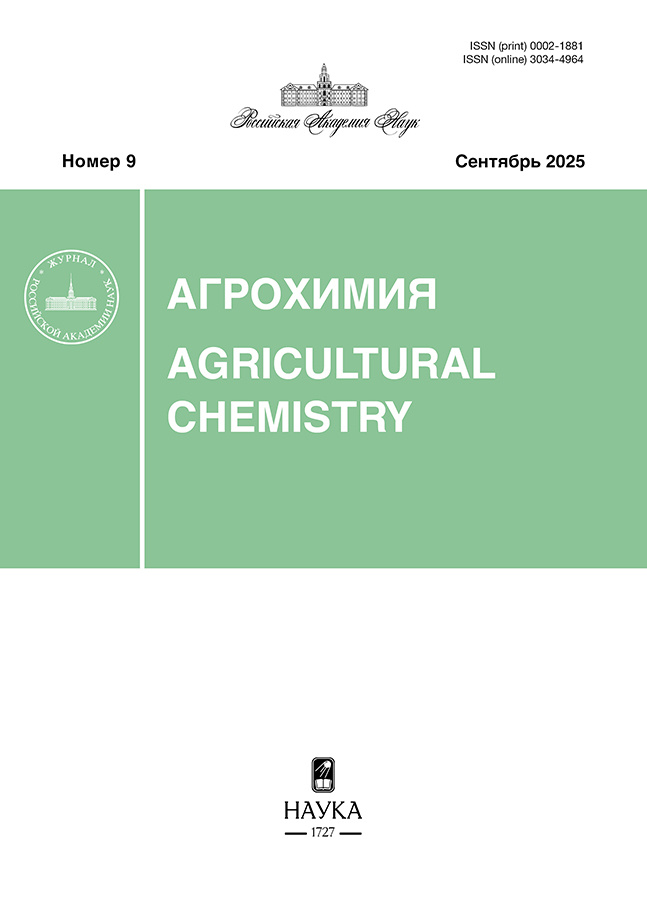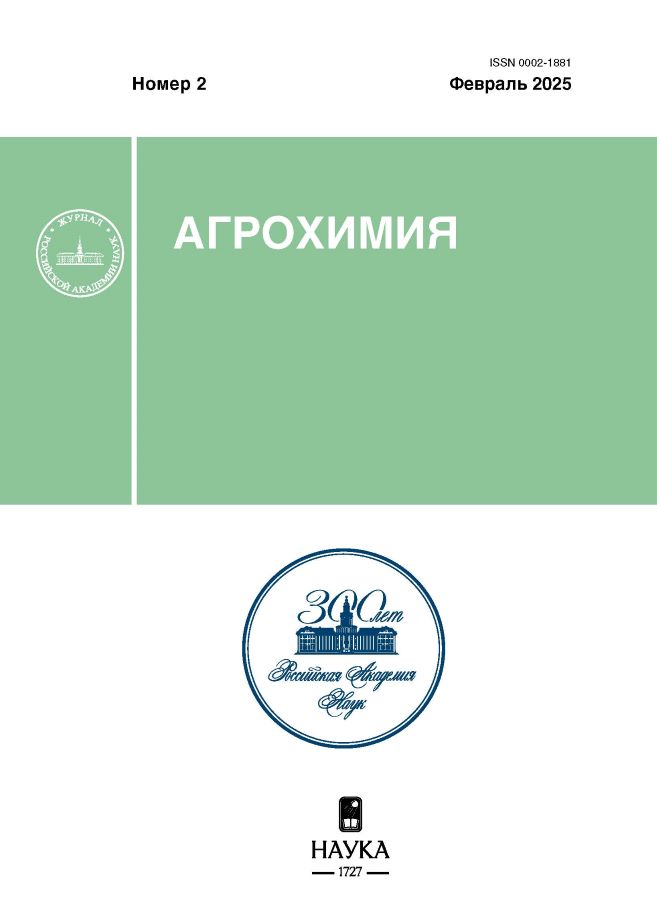Влияние обработки корней проростков пшеницы (Triticum aestivum L.) лектинами Azospirillum на устойчивость к абиотическому стрессу
- Авторы: Аленькина С.A.1, Купряшина М.А.1
-
Учреждения:
- ФИЦ “Саратовский научный центр РАН”
- Выпуск: № 2 (2025)
- Страницы: 47-55
- Раздел: Агроэкология
- URL: https://medjrf.com/0002-1881/article/view/684894
- DOI: https://doi.org/10.31857/S0002188125020069
- EDN: https://elibrary.ru/vbneff
- ID: 684894
Цитировать
Полный текст
Аннотация
Известно, что ростостимулирующие ризобактерии рода Azospirillum оказывают влияние на устойчивость растений к абиотическому стрессу, однако механизмы, лежащие в основе этого процесса, остаются неясными. В работе исследовали влияние лектинов азоспирилл на засухоустойчивость пшеницы Triticum aestivum. Поверхностные лектины штаммов A. brasilense Sp7 и A. baldaniorum Sp245 способны присоединяться к специфическим углеводам и обеспечивать связывание бактерий с поверхностью корня растения. Они обладают полифункциональностью, а эффекты, вызываемые лектинами, носят дозозависимый характер. В корнях проростков пшеницы в условиях засушливого стресса лектины с различной интенсивностью повышали активность пероксидазы, супероксиддисмутазы и каталазы. Лектины уменьшали перекисное окисление липидов, но увеличивали содержание вторичных метаболитов, таких как общие фенолы и флавоноиды. В корнях стрессированных проростков лектины вызывали дозозависимое увеличение содержания общего белка и приводили к изменению электрофоретических спектров низкомолекулярных белков. Полученные результаты позволили сделать вывод, что использование лектинов может обеспечить доступное и простое решение повышения продуктивности сельскохозяйственных культур в условиях ограниченной доступности воды.
Ключевые слова
Полный текст
Об авторах
С. A. Аленькина
ФИЦ “Саратовский научный центр РАН”
Автор, ответственный за переписку.
Email: s.alenkina@yandex.ru
Институт биохимии и физиологии растений и микроорганизмов
Россия, 410049 Саратов, просп. Энтузиастов, 13М. А. Купряшина
ФИЦ “Саратовский научный центр РАН”
Email: s.alenkina@yandex.ru
Институт биохимии и физиологии растений и микроорганизмов
Россия, 410049 Саратов, просп. Энтузиастов, 13Список литературы
- Takahashi F., Kuromori T., Urano K., Yamaguchi-Shinozaki K., Shinozaki K. Drought stress responses and resistance in plants: from cellular responses to long-distance intercellular communication // Front. Plant Sci. 2020. V. 11. P. 556972.
- Oguz M.C., Aycan M., Oguz E., Poyraz I., Yildiz M. Drought stress tolerance in plants: interplay of molecular, biochemical and physiological responses in important development stages // Physiologia. 2022. V. 2. P. 180–197.
- Puente M.L., Gualpa G.L., Lopez G.A., Molina R.M., Carletti S.M., Cassán F.D. The benefits of foliar inoculation with Azospirillum brasilense in soybean are explained by an auxin signaling model // Symbiosis. 2018. V. 76. P. 41–49.
- Bhattacharyya P.N., Jha D.K. Plant growth-promoting rhizobacteria (PGPR): emergence in agriculture // World J. Microbiol. Biotechnol. 2012. V. 28. P. 1327–1350.
- Cassan F., Diaz-Zorita M. Azospirillum sp. in current agriculture: From the laboratory to the field // Soil Biol. Biochem. 2016. V. 103. P. 117–130.
- Lana M., Dartora J., Marini D., Hann J. Inoculation with Azospirillum, associated with nitrogen fertilization in maize // Rev. Ceres Viçosa. 2012. V. 59. P. 399–405.
- Laus M.C., Logman T.J., Lamers G.E., Van Brussel A.N., Carlson R.W., Kijne J.W. A novel polar surface polysaccharide from Rhizobium leguminosarum binds host plant lectin // Mol. Microbiol. 2006. V. 59(6). P. 61704–61713.
- Антонюк Л.П., Евсеева Н.В. Лектин пшеницы как фактор растительно-микробной коммуникации и белок стрессового ответа // Микробиология. 2006. Т. 75. № 4. С. 544–549.
- Castellanos T., Ascencio F., Bashan Y. Cell-surface lectins of Azospirillum spp. // Curr. Microbiol. 1998. V. 36. P. 241–244.
- Никитина В.Е., Пономарева Е.Г., Аленькина С.А. Лектины клеточной поверхности азоспирилл и их роль в ассоциативных взаимоотношениях с растениями // Молекулярные основы взаимоотношений ассоциативных микроорганизмов с растениями / Под ред. В.В. Игнатова. М.: Наука, 2005. С. 70–97.
- Alen’kina S.A., Payusova O.A., Nikitina V.E. Effect of Azospirillum lectins on the activities of wheat-root hydrolytic enzymes // Plant and Soil. 2006. V. 283. P. 147–151.
- Alen’kina S.A., Bogatyrev V.A., Matora L.Yu., Sokolova M.K., Chernysheva M.P., Trutneva K.A., Nikitina V.E. Signal effects of the lectin from the associative nitrogen-fixing bacterium Azospirillum brasilense Sp7 in bacterial-plant root interactions // Plant and Soil. 2014. V. 381. P. 337–349.
- Alen’kina S.А., Romanov N.I., Nikitina V.Е. Regulation by Azospirillum lectins of the activity of antioxidant enzymes in wheat seedling roots under short-term stresses // Brazil. J. Bot. 2018 V. 41. P. 579–587.
- Аленькина С.A., Никитина В.Е. Влияние лектинов азоспирилл на активность аскорбатпероксидазы и содержание аскорбиновой кислоты в корнях проростков пшеницы при абиотических стрессах // Прикл. биохим. и микробиол. 2020. Т. 56. № 2. С. 174–181.
- Аленькина С.A., Никитина В.Е. Cтимулирующий эффект лектинов ассоциативных бактерий рода Azospirillum на всхожесть и морфометрические характеристики проростков яровой пшеницы при смоделированных абиотических стрессах // Физиология растений. 2021. Т. 68. № 2. С. 1–7.
- Хайруллин Р.M., Яруллина Л.Г., Трошина Н.Б., Ахметова И.Э. Активация хитоолигосахаридами окисления орто-фенилендиамина проростками пшеницы в присутствии щавелевой кислоты // Биохимия. 2001. Т. 66. № 3. С. 354–358.
- Aebi H. Catalase in vitro // Methods in Enzymology / Ed. Packer L. San Diego: Academic Press, 1984. V. 105. P. 121–126.
- Alscher R.G., Erturk N., Heath L.S. Role of superoxide dismutases (SODs) in controlling oxidative stress plants // J. Exp. Bot. 2002. V. 53. P. 1331–1341.
- Makkar H.P.S., Siddhuraju P., Becker K. Trypsin inhibitor // Plant Secondary Metabolites. N.J.: Humana Press, Totowa, 2007. V. 393. P. 1–122.
- Marinova D., Ribarova F., Atanassova M. Total phenolics and total flavonoids in bulgarian fruits and vegetables // J. Univer. Chem. Technol. Metall. 2005. V. 40. P. 255–260.
- Wu H., Wu X., Li Z., Duan L., Zhang M. Physiological evaluation of drought stress tolerance and recovery in cauliflower (Brassica leracea L.) seedlings treated with methyl jasmonate and coronatine // J. Plant Growth Regul. 2012. V. 31. P. 113–123.
- Bradford M.M. A rapid and sensitive method for the quantitation of microgram quantities of protein utilizing the principle of protein-dye binding // Anal. Biochem. 1976. V. 72. P. 248–254.
- Laemmli U.K. Cleavage of structural proteins during the assembly of the read of bacteriophage // Nature. 1970. V. 227(5259). P. 680–685.
- Ashraf M. Biotechnological approach of improving plant salt tolerance using antioxidants as markers // Biotechno. Adv. 2009. V. 27. P. 84–93.
- Ishikawa T., Takahara K., Hirabayashi T., Matsumura H., Fujisawa S., Terauchi R., Kawai-Yamada M. Metabolome analysis of response to oxidative stress in rice suspension cells overexpressing cell death suppressor Bax inhibitor-1 // Plant Cell Physiol. 2010. V. 51(1). P. 9–20.
- Huseynova I.M. Photosynthetic characteristics and enzymatic antioxidant capacity of leaves from wheat cultivars exposed to drought // Biochim. Biophys. Acta (BBA)–Bioenerg. 2012. V. 1817(8). P. 1516–1523.
- Guidi L., Tattini M. Antioxidant defenses in plants: a dated topic of current interest // Antioxidants. 2021. V. 10(6). P. 855.
- Horváth E., Pál M., Szalai G., Páldi E., Janda T. Exogenous 4-hydroxybenzoic acid and salicylic acid modulate the effect of short term drought and freezing stress on wheat plants // Biol. Plantarum. 2007. V. 51(3). P. 480–487.
- Arzanesh M.H., Alikhani H.A., Khavazi K., Rahimian H.A., Miransari M. In vitro growth of wheat (Triticum aestivum L.) seedlings, inoculated with Azospirillum sp., under drought stress // Inter. J. Bot. 2009. V. 5. P. 244–249.
- Darkó É., Fodor J., Dulai S., Ambrus H., Szenzenstein A., Király Z., Barnabás B. Improved cold and drought tolerance of doubled haploid maize plants selected for resistance to prooxidant tert-butyl hydroperoxide // J. Agron. Crop Sci. 2011. V. 197(6). P. 454–465.
- Georgiadou E.C., Ntourou T., Goulas V., Manganaris G.A., Kalaitzis P., Fotopoulos V. Temporal analysis reveals a key role for VTE5 in vitamin E biosynthesis in olive fruit during on-tree development // Front. Plant Sci. 2015. V. 6. P. 871.
- Ahmad Z., Waraich E.A., Akhtar S., Anjum S., Ahmad T., Mahboob W., Rizwan M. Physiological responses of wheat to drought stress and its mitigation approaches // Acta Physiol. Plantarum. 2018. V. 40(4). P. 80.
- Kotak S., Larkindale J., Lee U., von Koskull-Doring P., Vierling E., Scharf K.D. Complexity of the heat stress response in plants // Curr. Opin. Plant Biol. 2007. V. 10. P. 310–316.
- Kosmala Ar., Bocian Al., Rapicz M., Jurczyk B., Zwierzykowski Zb. Identification of leaf proteins differentially accumulated during cold acclimation between Festuca pratensis plants with distinct level of frost tolerance // J. Exp. Bot. 2009. V. 60. P. 3595–3609.
- Cheng G., Basha E., Wysocki V.H., Vierling E. Insights into small heat shock protein substrate structure during chaperone action derived from hydrogen/deuterium exchange and mass spectrometry // J. Biol. Chem. 2008. V. 283. P. 26634–26642.
- Шелудько А.В., Пономарева Е.Г., Варшаломидзе О.Э., Ветчинкина Е.И., Кацы Е.И., Никитина В.Е. Гемагглютинирующая активность и подвижность бактерий Azospirillum brasilense в присутствии разных источников азота // Микробиология. 2009. Т. 78. № 6. С. 749–756.
Дополнительные файлы















